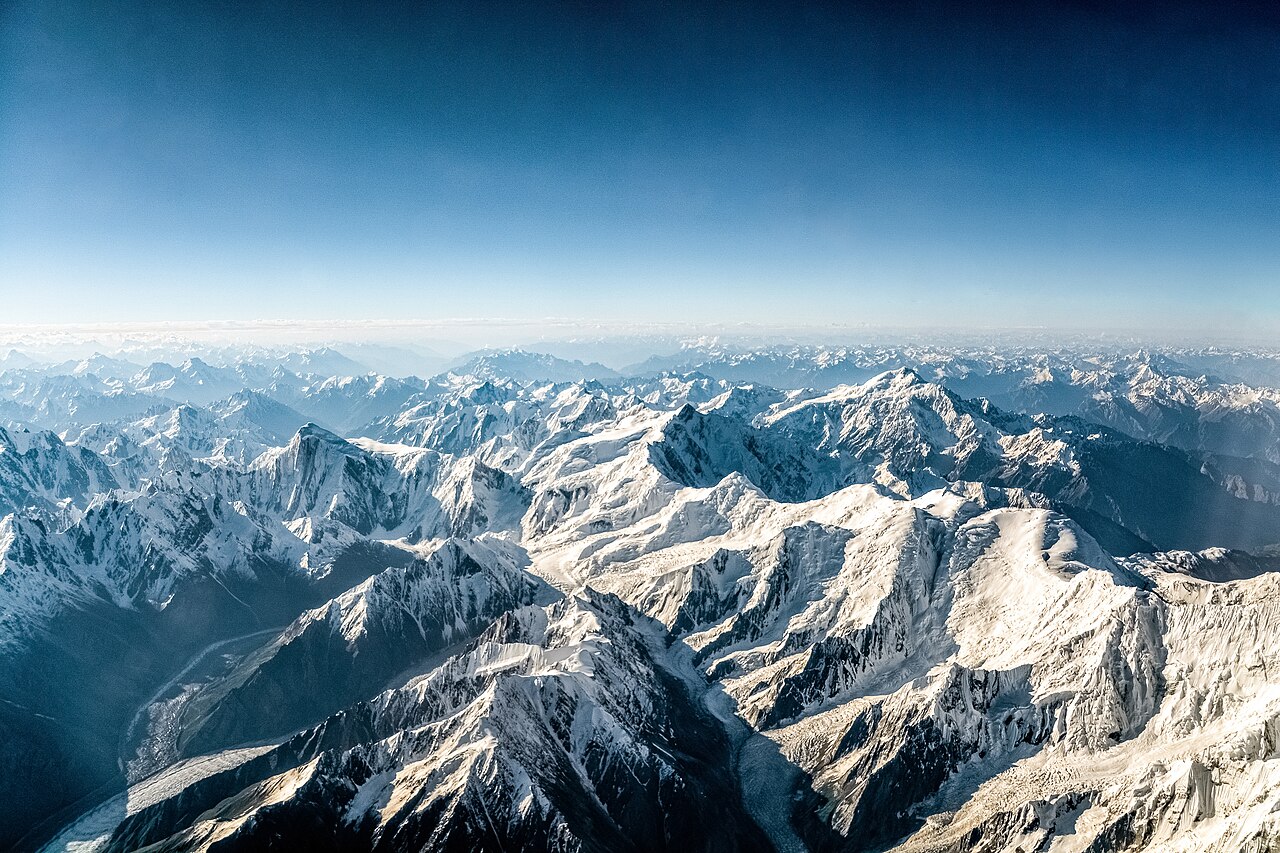Climate change, deforestation, hydroelectric projects, unregulated tourism, and urbanisation are posing a threat to the country's mountain ranges.
Published Jul 30, 2024 | 7:00 AM ⚊ Updated Jul 30, 2024 | 7:00 AM

The degradation of the Himalayas is driven more by local and regional factors rather than global warming. (Jeremy Zero/Wikimedia Commons)
With its magnificent mountains, deserts, and coastlines, India is a land handcrafted by God.
Perhaps, the most vital regions are the Himalayas and the Western Ghats. The snowmelt of the Himalayas provides water to millions of people in the Indo-Gangetic plains while the Western Ghats play with the clouds and provide succour to Peninsular India.
Unfortunately, over the decades, policy-makers have failed to see the need to protect these precious regions that are the catchment areas for rivers that sustain a bulk of the Indian population by providing water for drinking, agriculture, and industries.
The Himalayas stand tall at over 20,000 feet above sea level. Its snow and glacier melt give birth to several rivers, including the Indus, Beas, Sutlej, Yamuna, Ganga, and Brahmaputra.
These rivers sustain a vast multitude of the Indian population across the Indo-Gangetic plains. It is therefore a matter of grave concern that the Himalayas are being rapidly degraded due to climate change with alarming rates of glacier retreat coupled with reduced snowfall.
Hydroelectric projects, unregulated tourism, and urbanisation are among the leading causes of the degradation of the Himalayan ecosystem. The June 2013 tragedy in Uttarakhand — the mid-day cloudburst that triggered a catastrophe — appears to have been forgotten in the relentless pursuit of development.
Besides a rise in temperatures due to global warming, local and regional forces are also responsible for the recurring tragedies. Loss of tree cover, massive emissions of black carbon — or soot — and increasing demographic pressure are also taking a toll on the Himalayas.
The degradation of the Himalayas is driven more by local and regional factors rather than global warming.
A 1,600-kilometre hill range close to the coast, extending from Gujarat to Tamil Nadu, forms the Western Ghats. The Bhima, Godavari, Krishna, and Cauvery are some of the major rivers that flow down the Western Ghats, and provide water to peninsular India.
The Western Ghats are also subjected to degradation in ways similar to the Himalayas. These precious mountains have been torn up by linear development projects and large areas have been inundated due to the construction of dams.
Additionally, rapid and unregulated urbanisation along with invasive tourism also adds to the demographic pressure on the Western Ghats.
The problem is rooted in the fact that India lacks a catchment area policy to protect these regions.
There was an effort by the government which constituted the Western Ghats Ecology Expert Panel (WGEEP) in 2010, headed by Dr Madhav Gadgil. The recommendations of this panel were a catchment area protection policy for the Western Ghats.
Unfortunately, powerful vested interests ensured that the WGEEP recommendations were shelved and this panel was replaced by the High-Level Working Group (HLWG) headed by Dr K Kasturirangan with the stated purpose of examining the WGEEP recommendations.
The recommendations of the HLWG were a much diluted version of the WGEEP report, but even they were strongly opposed by various states and the recommendations have yet to be properly ratified and implemented.
Meanwhile, in the absence of a comprehensive and well-planned strategy and policy, floods, droughts, and other natural disasters continue to ravage the country.
Moreover, the resultant degradation of forest habitat has given rise to escalating levels of human-wildlife conflict.
It is therefore imperative that the recommendations of the WGEEP and the HLWG be reviewed to formulate a catchment area protection policy not only for the Western Ghats but also for other catchment areas, including the Himalayas, the Aravalli Ranges, the Vindhyas and the Eastern Ghats.
The Ministry of Water Resources should draft the catchment area policy in tandem with the Ministry of Environment, Forest and Climate Change and NITI Aayog. The draft policy should be placed in the public domain and then ratified for implementation.
The entire process should not take more than 12 months.
Specific to the Himalayas, there will be a need for cooperation with other nations that share the Himalayas as well as the countries of the Mekong Basin.
At present there is a proposal for mitigation of Climate change in this region. It has been drafted by our organisation, the Environment and Health Foundation (India). It has been termed as the HIMEK Alliance proposal for the mitigation of climate change in the Himalayas and the contiguous Mekong region.
The proposal envisages a two-pronged strategy, including large-scale forest land restoration and a drastic reduction in black carbon emissions.
The Asian Regional Office of the International Union for Conservation of Nature and the Asian Institute of Technology have signed an MoU based on the HIMEK Alliance proposal in 2018 and it is hoped that there will be support from the respective national governments to protect the Himalayas and the numerous river systems originating from these mountains.
Another point for consideration is the proposed river interlinking scheme and the Sagar Mala projects must be reviewed in the larger interests of protecting our river systems and catchment areas.
Political vision and will can result in a win-win situation. But we do not have the luxury of time. Climate change is not about pictures of polar bears stranded on floating ice sheets in the distant Arctic: it is a grim reality that is already at our doorstep.
We, therefore, need to move ahead with determination and with a sense of urgency.
(Colonel CP Muthanna (Retd) is the Chair, Kodagu Model Forest Trust, Founder and Hon Secretary, Environment and Health Foundation (India) & Former President, Coorg Wildlife Society. Views are personal. Edited by Majnu Babu).
(South First is now on WhatsApp and Telegram)
